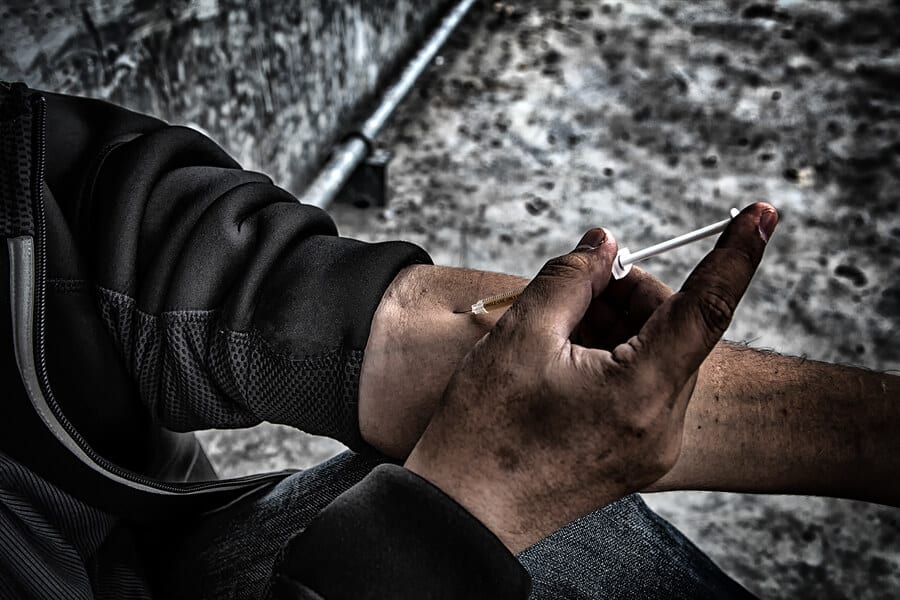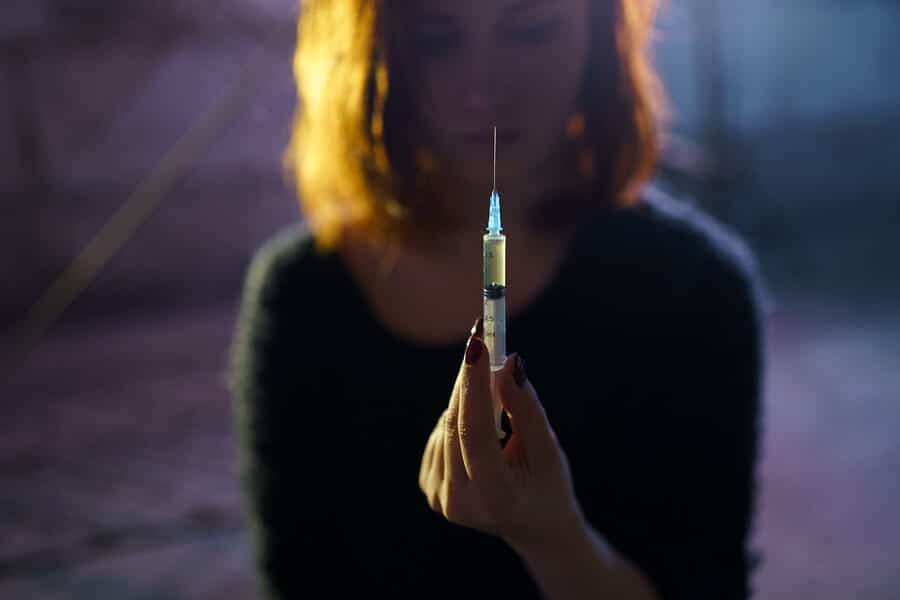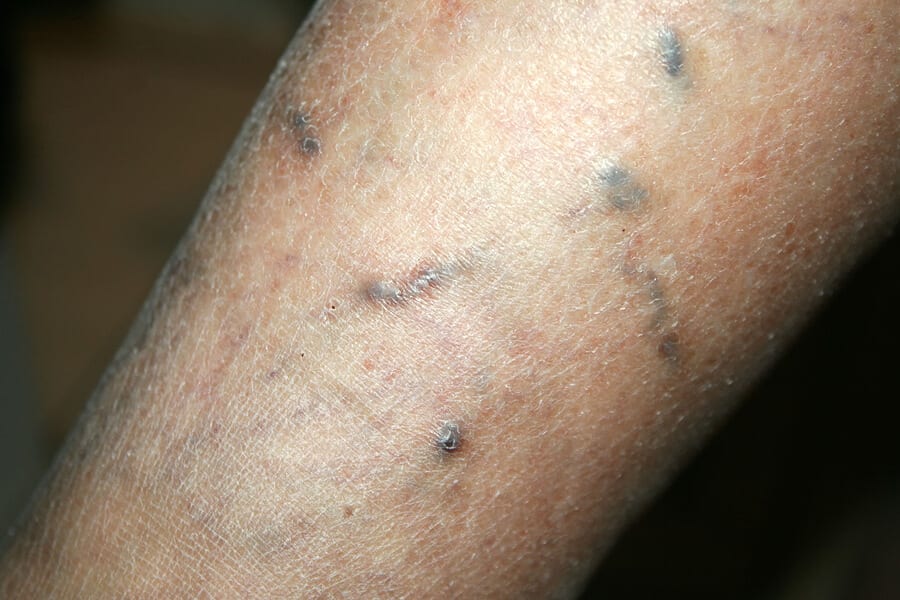
Intravenous Drug Use Infections – Intravenous drug use has been associated with many serious health risks. Injecting drugs places the user at an increased risk of contracting various infections and bloodborne diseases.
The most commonly injected drugs are opioids, such as heroin, fentanyl, and oxycodone. However, cocaine, meth, and anabolic steroids are also sometimes injected. Any drug that can be broken down into a powder form and mixed with water and/or liquified can be used intravenously.
How Intravenous Drug Use Causes Infection
Bacterial infections may develop when germs that live on the surface of the skin or contaminated needle are pushed deeper into the skin and the body during intravenous (IV) drug use. When this occurs, these germs are able to bypass the normal barriers and skin defenses that are there to protect us from these invaders.
Should the infection-causing bacteria reach the blood vessels, this may lead to extensive deep-tissue or vein infection. The contraction of bloodborne diseases, such as HIV and Hepatitis C, is also common among users who share unsterilized needles and other paraphernalia used for injection purposes.
For IV drug users living in poor conditions, such as on the streets or in unkempt drug den-like environments, a lack of hygiene can also contribute to the risk of acquiring other infections. The risk of infection is even higher when these factors are combined with malnutrition and impaired immunity, two conditions that are frequently associated with severe drug use.
Common Drugs for Intravenous Drug Use
As noted, the most common type of injected drugs are opioids, the most popular of which is heroin. Other opioid drugs frequently abused, either intentionally or unknowingly, are fentanyl and its analogs. Also, prescription painkillers can be crushed into a powder and then dissolved into a solution for injection.
Opioid use is associated with several physical effects, including the following:
- A rush of euphoria
- Drowsiness
- Reduced attentiveness
- Memory problems
- Impaired judgment
- Impulsive behavior
Symptoms of an opioid overdose include:
- Slowed or stopped breathing
- Pinpoint pupils
- Loss of consciousness
- Coma
- Respiratory arrest
- Death
Other central nervous system (CNS) depressants, such as benzodiazepines, are sometimes abused by dissolving them and then injecting them, either alone or in conjunction with opioids or other drugs.
Stimulants are also popular with IV drug users because they quickly deliver a strong rush of euphoria, as well as increased energy, appetite suppression, and a reduced need for sleep. Cocaine, meth, and prescription stimulants such as Adderall are the most commonly injected.

Infections from Intravenous Drug Use
Infections related to intravenous drug use include the following:
Staph Infections
Staphylococcus (staph) infections are among the most common types of infections related to intravenous drug use. It can manifest as a bump or boil that resembles a pimple or a spider bite, and the area may be red, swollen, and sore to the touch.
If a staph infection spreads to the lungs, it can induce symptoms of pneumonia, such as chills, fever, cough with yellowish or greenish sputum, and chest pain when breathing or coughing. The most common treatment for a staph infection involves a course of IV antibiotics and wound drainage.
Abscesses
Abscesses are tender masses of flesh surrounded by inflamed tissue. The center of the abscess is often filled with pus, bacteria, and other debris. If the infection spreads, fever and nausea may develop. If the infection is severe, antibiotics may be prescribed.
While some abscesses drain on their own, many need to be opened and drained by a doctor and then packed with gauze to prevent bleeding. Especially large abscesses that go unaddressed for an extended period are often slow to respond or resistant to antibiotics.
Cellulitis
Symptoms of this skin infection include pain, fever, red streaking of the skin, swelling, tenderness, swollen lymph nodes, and leakage of yellow fluid from blisters. Treatments for cellulitis include oral antibiotics and elevation of the afflicted areas. Severe cellulitis may require hospital admission for IV antibiotics.
Necrotizing Fasciitis
Necrotizing fasciitis is a very serious condition. This infection, which is also commonly known as flesh-eating disease, can erupt suddenly and with little warning. Bacteria enters and propagates throughout the tissue beneath the skin, which in turn becomes red, swollen, and hot to the touch. Patients may also experience fever, chills, nausea, vomiting, and diarrhea.
When the bacteria in this condition spreads, the skin becomes black as gangrene begins to develop. If an infection is allowed to continue spreading, it may affect vital organs and can result in death. Treatments include surgery, antibiotics, and hyperbaric oxygen therapy. In extreme cases, amputation of the infected limb may be required.
Tetanus
When spores from the Clostridium tetani bacteria invade the bloodstream via an open wound caused by an IV injection, tetanus can develop. Symptoms include spasms and tension in the jaw, neck, chest, and back. Generalized muscle spasms may lead to arching of the back known as opisthotonos.
Spasms associated with tetanus can affect breathing, and muscle contractions can become very intense and painful. Drooling, difficulty swallowing, fever, and irritability are also possible symptoms of tetanus. Treatments include tetanus immunoglobulin, antibiotics, sedative, and muscle relaxers.
Botulism
Botulism is a condition that develops after exposure to certain bacterial toxins. It has the potential to be lethal when left unaddressed and is hallmarked by flaccid paralysis of muscles.
Other botulism symptoms can include blurry vision, dry mouth, muscle weakness, slurred speech, difficulty swallowing, drooping eyelids, and constipation. Severe cases of botulism can lead to respiratory failure. It is treated using antitoxins to neutralize the neurotoxins in the blood.
Bacterial Endocarditis
Bacterial endocarditis is an infection of the heart valve that occurs when certain bacteria circulate through the bloodstream and begin to invade the heart muscle. Symptoms may include unintentional weight loss, fatigue, chills, fever, night sweats, back and abdominal pain, muscle aches and weakness, and stiff neck. Treatment for this condition typically includes IV antibiotics and possibly, heart surgery to repair or replace the affected heart valves.
Septic Thrombophlebitis
Septic thrombophlebitis is a subcutaneous vascular bacterial infection hallmarked by tender and swollen arms and legs. Symptoms include skin redness around a vein, localized swelling in an arm or leg, chills, fever, and fatigue.
If the condition worsens, symptoms may include breathing difficulties, hypotension, rapid pulse, impaired urination, confusion, and coma. Treatments for this condition include antibiotics, non-steroidal anti-inflammatory drugs, anticoagulants, and sometimes surgery to remove the infected vein.

Hepatitis C
Hepatitis C is a viral infection that is easily spread via sexual intercourse and intravenous drug use. Telltale signs of this disease include abdominal pain, extreme fatigue, itchy skin, sore muscles, and dark urine.
An afflicted individual may also exhibit bleeding, redness on the palms and feet, and jaundice. Hepatitis C infection is treated with antiviral drugs that eliminate the virus from the body.
HIV
HIV (human immunodeficiency virus) infection can lead to the development of chronic autoimmune disease. Symptoms of HIV infection are often first falsely diagnosed as the flu and may include chills, fever, body aches, diarrhea, sore throat, nausea, and vomiting.
As the disease advances, the person may develop chronic itchy and flaky skin, oral thrush, extreme malaise, shingles, short-term memory impairment, and unintentional weight loss. Although there is no cure, many people with HIV live normal, active lives with appropriate treatment, which includes a variety of antiretroviral drugs used daily to suppress the virus and reduce its ability to spread.
Getting Treatment for IV Drug Use and Addiction
The misuse or abuse of any illicit drugs can be incredibly dangerous, but those risks are even higher when drug use is facilitated by IV injection. If you or someone you love is engaging in this type of drug abuse, or any substance abuse, please contact us immediately to discuss treatment options.
Harmony Recovery is a specialized addiction treatment center that offers multiple evidence-based therapies proven to be vital to the recovery process, including cognitive-behavioral therapy, counseling, group support, medication-assisted treatment, and more.
Our team of highly-skilled, caring addiction specialists is dedicated to providing each client with the resources, tools, and support they need to achieve a full recovery and maintain long-lasting sobriety and wellness. Contact us today to find out how we can help!
Related: List of Opioids Strongest To Weakest